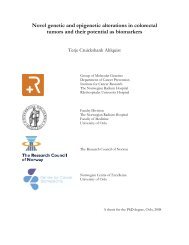Preface - Ous-research.no
Preface - Ous-research.no
Preface - Ous-research.no
Create successful ePaper yourself
Turn your PDF publications into a flip-book with our unique Google optimized e-Paper software.
Integrated Cardiovascular Function<br />
Furthermore, we have identified a new regional marker<br />
for mechanical activation based on a segment’s first sign<br />
of active force generation (onset AFG). Using onset AFG<br />
we have been able to discriminate between electrical and<br />
mechanical dyssynchrony because onset AFG accurately<br />
reflect regional electrical activation (Fig1). This is important<br />
when assessing patients for CRT since primary electrical<br />
dyssynchrony is more likely to respond to the therapy. Our<br />
experimental findings have been very promising and we<br />
have <strong>no</strong>w started patient based studies. Electrical activation<br />
sequence also influences regional work distribution<br />
in the LV. Using strain data (% myocardial deformation) by<br />
echocardiography in combination with LV pressure allows<br />
for assessment of regional work. We are currently working<br />
on a new method to detect wasted work done during<br />
Figure 2. Transmural mechanical dispersion in a symptomatic<br />
LQTS patient. Shown are the longitudinal (left) and circumferential<br />
(right) strain curves from a symptomatic LQTS patient. The<br />
anterior basal septal segment from longitudinal strain (left, red<br />
curve) shows a contraction duration of 460 milliseconds. From<br />
circumferential strain, the contraction duration from the anterior<br />
basal septal segment (right, yellow curve) is 360 milliseconds. Subendocardial<br />
contraction duration (longitudinal strain) therefore<br />
is markedly prolonged com- pared with midmyocardial contraction<br />
duration (circumferential strain), indicating transmural<br />
mechanical dispersion.<br />
continue to investigate how LV myocardial mechanical dispersion<br />
relates to risk for ventricular arrhythmias in ischemic<br />
heart disease and in different types of cardiomyopathies.<br />
20<br />
Figure 1. Assessment of onset active force generation (AFG) by<br />
LV pressure and strain by speckle tracking echocardiography. Representative<br />
traces from septal (thick lilac trace) and lateral (thin<br />
green trace) segments during left bundle branch block (LBBB).<br />
Strain measurements are performed in short axis view. Vertical<br />
dotted line represents regional electrical activation by intramyocardial<br />
electromyogram (IM-EMG). Aortic valve opening (AVO)<br />
and closing (AVC) indicated by arrow.<br />
LBBB, which can subsequently be reversed by bi-ventricular<br />
pacing.<br />
2. LV mechanical-electrical interactions: Evaluating patients<br />
with susceptibility for cardiac arrhythmias and sudden<br />
cardiac death is a major challenge in daily cardiology<br />
practice. Electrophysiological studies have demonstrated<br />
that damaged myocardium (e.g. infarcted or genetically<br />
altered) provides the substrate for malignant arrhythmias.<br />
Echocardiographic techniques can accurately quantify regional<br />
myocardial function. There is limited insight into how<br />
regional mechanical dysfunction may predict risk for ventricular<br />
arrhythmias. We have recently demonstrated how<br />
mechanical dispersion can predict ventricular arrhythmias<br />
in patients with LQT syndrome and in myocardial infarction.<br />
One study about mechanisms for ventricular arrhythmias in<br />
LQT syndrome was published in Circulation (Fig 2). We will<br />
3. Diastolic dysfunction: Left ventricular function has traditionally<br />
been evaluated <strong>no</strong>n-invasively in terms of ejection<br />
fraction (LVEF). The assessment of LVEF is important for<br />
diag<strong>no</strong>stics, prog<strong>no</strong>sis and selection of treatment. Many patients<br />
with symptoms of heart failure have, however, <strong>no</strong>rmal<br />
ejection fraction and appear to have diastolic heart failure.<br />
In this patient group there is need for other measures than<br />
ejection fraction. We are studying LV diastolic lengthening<br />
rate and LV untwisting rate and how these indices may be<br />
used as markers of LV diastolic dysfunction. In addition to<br />
experimental models we utilize mathematical heart modeling<br />
to explore our ideas. This includes finite element simulation<br />
to interpret measurements of myocardial wall deformation<br />
under <strong>no</strong>rmal and diseased conditions. The recently<br />
introduced method speckle tracking echocardiography<br />
represents a simplified, objective and angle-independent<br />
modality for quantification of regional myocardial deformation.<br />
The software utilizes conventional grayscale B-mode<br />
recordings, and tracks myocardial speckles which serve as<br />
natural acoustic markers. Radial and longitudinal myocardial<br />
deformation can be measured simultaneously from longaxis<br />
recordings, radial and circumferential deformation from<br />
short-axis recordings and LV torsion from assessment of<br />
apical and basal short-axis rotation.<br />
Patients with acute decompensated heart failure (ADHF)<br />
suffer from increased morbidity and mortality. The hemodynamic<br />
assessment of ADHF offers the potential of tailored<br />
therapy. However, the invasive gold standard is <strong>no</strong>t without<br />
risks. Accordingly the <strong>no</strong>n-invasive assessment by Doppler
















